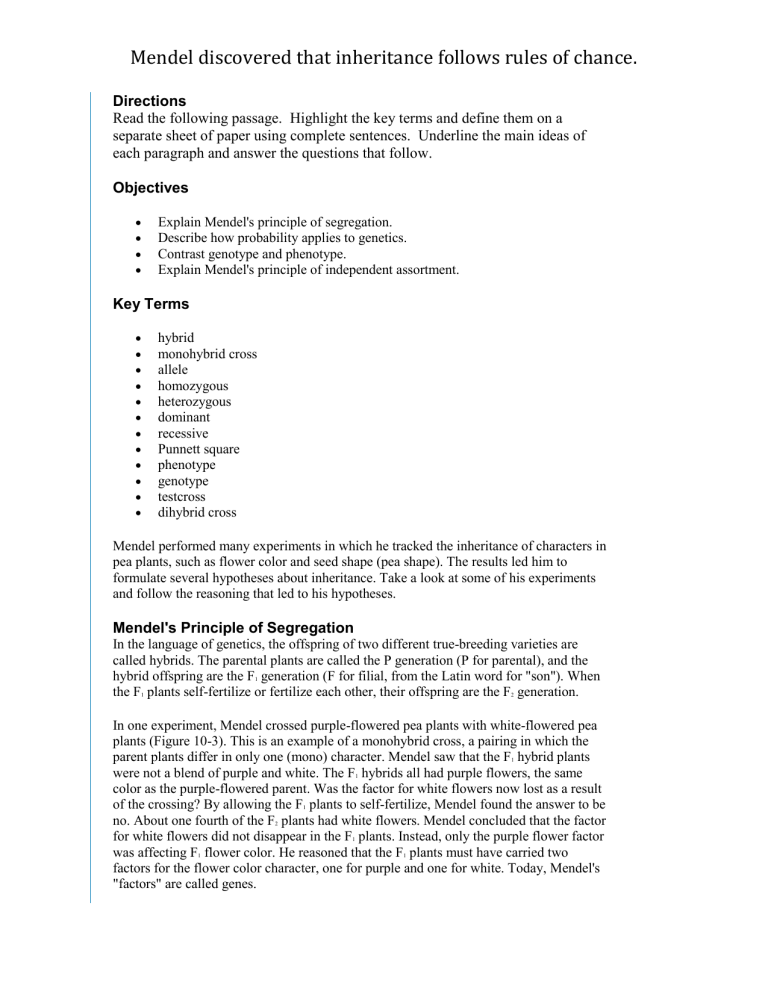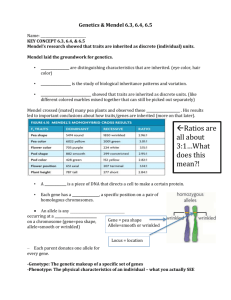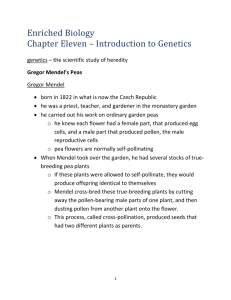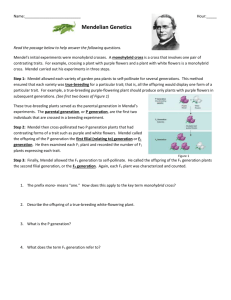Mendel discovered that inheritance follows rules of chance.

Mendel discovered that inheritance follows rules of chance.
Directions
Read the following passage. Highlight the key terms and define them on a separate sheet of paper using complete sentences. Underline the main ideas of each paragraph and answer the questions that follow.
Objectives
Explain Mendel's principle of segregation.
Describe how probability applies to genetics.
Contrast genotype and phenotype.
Explain Mendel's principle of independent assortment.
Key Terms
hybrid monohybrid cross allele homozygous
heterozygous dominant
recessive
Punnett square
phenotype genotype testcross dihybrid cross
Mendel performed many experiments in which he tracked the inheritance of characters in pea plants, such as flower color and seed shape (pea shape). The results led him to formulate several hypotheses about inheritance. Take a look at some of his experiments and follow the reasoning that led to his hypotheses.
Mendel's Principle of Segregation
In the language of genetics, the offspring of two different true-breeding varieties are called hybrids. The parental plants are called the P generation (P for parental), and the hybrid offspring are the F
1
generation (F for filial, from the Latin word for "son"). When the F
1
plants self-fertilize or fertilize each other, their offspring are the F
2
generation.
In one experiment, Mendel crossed purple-flowered pea plants with white-flowered pea plants (Figure 10-3). This is an example of a monohybrid cross, a pairing in which the parent plants differ in only one (mono) character. Mendel saw that the F
1
hybrid plants were not a blend of purple and white. The F
1
hybrids all had purple flowers, the same color as the purple-flowered parent. Was the factor for white flowers now lost as a result of the crossing? By allowing the F
1
plants to self-fertilize, Mendel found the answer to be no. About one fourth of the F
2
plants had white flowers. Mendel concluded that the factor for white flowers did not disappear in the F
1
plants. Instead, only the purple flower factor was affecting F
1
flower color. He reasoned that the F
1
plants must have carried two factors for the flower color character, one for purple and one for white. Today, Mendel's
"factors" are called genes.
Mendel discovered that inheritance follows rules of chance.
Figure 10-3
For each monohybrid cross, Mendel cross-fertilized true-breeding plants that were different in just one character
—in this case, flower color. He then allowed the hybrids (the F
1
generation) to self-fertilize.
In addition to studying the inheritance patterns of flower color, Mendel used monohybrid crosses to investigate six other pea plant characters (Figure 10-4). Each cross produced the same pattern. One of the two parent traits disappeared in the F
1
generation, but then reappeared in about one fourth of the F
2
offspring. From these results, Mendel developed four hypotheses. Using modern terms (such as gene instead of factor ), these hypotheses are as follows:
1.
There are alternative forms of genes. For example, the gene for flower color in pea plants exists in one form for purple and in another form for white. These alternative forms of genes are called alleles (uh LEELZ).
2.
For each inherited character, an organism has two alleles for the gene controlling that character, one from each parent. If the two alleles are the same, the individual is homozygous (hoh moh ZY gus) for that character. If the two alleles are different, the individual is heterozygous (het ur oh ZY gus).
3.
When only one of the two different alleles in a heterozygous individual appears to affect the trait, that allele is called the dominant allele. And in such cases, the other allele that does not appear to affect the trait is called the recessive allele. In this book, a capital letter is used to represent the name of a dominant allele (in the flower color example, P ). The lowercase version of the same letter is used to represent the recessive allele ( p ).
4.
The two alleles for a character segregate (separate) during the formation of gametes (sex cells), so that each gamete carries only one allele for each character. This is known as Mendel's principle of segregation.
The union of gametes during fertilization reforms allele pairs in the offspring.
Mendel discovered that inheritance follows rules of chance.
Figure 10-4
Mendel examined the inheritance patterns of seven different pea-plant characters. For each character, one of the two parent traits disappeared in the F
1
hybrids, but reappeared in approximately one quarter of the F
2
generation (not shown here).
Probability and Punnett Squares
In a monohybrid cross of true-breeding (homozygous) purple-flowered and whiteflowered plants, Mendel's hypotheses predict that each F
1
plant will get the dominant purple-flower allele ( P ) from one parent and the recessive white-flower allele ( p ) from the other parent. Each F
1
plant will be heterozygous: Pp.
Then the F
1
plants grow up and make gametes of their own. Each gamete receives only one allele for flower color, P or p, with equal likelihood.
As the F
1
plants fertilize each other, gametes combine randomly and form zygotes with pairs of alleles. The likelihood of each specific pair forming is key to the inheritance pattern seen in the F
2
generation. Consider the analogy of being handed two pennies
(Figure 10-5, left). As you look at the two pennies, you will see 2 heads or 1 head and 1 tail or 2 tails . (Note that there are two different ways to get the outcome of 1 head and 1 tail.) The side shown by one coin is unaffected by the side shown by the other coin. But what is the probability of a particular combination occurring? For example, what is the probability that you will see 2 heads? You can build a table that shows the probability of each combination. List the probabilities for the first coin along the top of a piece of paper, and the probabilities for the second coin along the edge of the paper. Create a grid as shown in Figure 10-5. The probability of a particular combination is the product of the separate probabilities for each coin. For example, the probability of 2 heads showing is
1/2 x 1/2 = 1/4.
Mendel discovered that inheritance follows rules of chance.
Figure 10-5
Punnett squares are used to calculate the probabilities of outcomes resulting from a genetic cross. The grid on the left predicts the probabilities of certain combinations of the two sides (alleles) of two pennies. The Punnett square on the right predicts that the two alleles for flower color will randomly pair in the same proportions as the two sides of the pennies.
In the same way, you can calculate the probabilities for different combinations of alleles resulting from a genetic cross. The gametes of the purple F
1
flowers pair randomly, making the allele combinations in the F
2
generation PP or Pp or pp (Figure 10-5, right).
(Again, note that there are two ways to get the heterozygous— Pp
—outcome.) This type of diagram that shows all possible outcomes of a genetic cross is called a Punnett square.
You can use a Punnett square to predict probabilities of particular outcomes if you know the genetic makeup of both parents.
Genotype and Phenotype
Now that you know how to predict the genetic makeup of the F
2
plants, what can you say about their appearance? In the prediction based on the Punnett square, one fourth of the
F
2
plants are homozygous for the purple allele—they have two alleles specifying purple flowers ( PP ). Clearly, these plants will have purple flowers. One half (1/4 + 1/4) of the
F
2
offspring are heterozygous—they have both types of allele ( Pp ). Like the F
1
plants, these plants will also have purple flowers, the dominant trait. Finally, one fourth of the F
2 plants are homozygous for the white-flower allele ( pp ). They will display the recessive trait, white flowers. Thus, Mendel's hypotheses account for the 3/4 : 1/4 or 3 : 1 ratio of flower color that he observed in the F
2
generation.
An observable trait (such as purple flowers) is called the phenotype (FEE noh type). The genetic makeup, or combination of alleles (such as PP ), is called the genotype (JEE noh type). For the F
2
plants, the ratio of plants with purple flowers to those with white flowers (3 purple : 1 white) is called the phenotypic ratio. The genotypic ratio is 1 PP : 2
Pp : 1 pp.
The Testcross
What is the genotype of an organism that displays the dominant phenotype? Suppose, for example, that you have a purple-flowered pea plant. Its genotype could be either of two possibilities: PP or Pp . To determine whether the purple-flowered plant is homozygous
( PP ) or heterozygous ( Pp ), you need to perform what geneticists call a testcross. A testcross breeds an individual of unknown genotype, but dominant phenotype (your
Mendel discovered that inheritance follows rules of chance. purple-flowered mystery plant) with a homozygous recessive individual—in this case, a white-flowered plant ( pp ).
The appearance of the offspring resulting from the testcross will reveal the genotype of the mystery plant. Because the homozygous recessive parent can only contribute a recessive allele to the offspring, the phenotype will indicate the allele contributed by the mystery plant. If the purple-flowered parent is homozygous, you would expect all of the offspring to be purple-flowered since the mystery plant can only contribute a P allele.
Thus, all offspring would be Pp (Figure 10-6, left). However, if the purple-flowered parent is heterozygous, you would expect both purple-flowered ( Pp ) and white-flowered
( pp ) offspring (Figure 10-6, right). Figure 10-6 also shows that the white-flowered and purple-flowered offspring of a Pp X pp testcross are predicted to have a 1 : 1 (1 purple to
1 white) ratio of phenotypes.
Figure 10-6
A testcross can reveal whether an organism that displays the dominant phenotype is homozygous or heterozygous.
Mendel's Principle of Independent Assortment
Two of the seven characters Mendel studied were qualities of the peas themselves: shape and color (see Figure 10-4). From his monohybrid crosses, Mendel knew that round pea shape was dominant to wrinkled shape, and yellow color was dominant to green. What would be the result of a dihybrid cross—crossing organisms differing in two characters?
Figure 10-7 outlines Mendel's results. Mendel crossed a true-breeding plant grown from a round yellow seed (genotype RRYY ) with a true-breeding plant grown from a wrinkled green seed (genotype rryy ). The first parent could only produce RY gametes. The other could only produce ry gametes. The union of these RY and ry gametes yielded hybrid peas heterozygous for both characters ( RrYy ). All peas had the dominant phenotype:
They were round and yellow.
Mendel discovered that inheritance follows rules of chance.
Figure 10-7
For each dihybrid cross, Mendel cross-fertilized true-breeding plants that were different in two characters. Then he allowed the F
1
hybrids to self-fertilize. In this case, the two characters, seed color and shape, are displayed by the first stage of each new generation, the seed (pea).
The hybrid peas grew into F
1
plants, which Mendel allowed to self-fertilize. This produced four phenotypes of peas. Assuming there are four equally likely combinations of alleles in the gametes produced by the F
1
generation— RY, rY, Ry, and ry
—a Punnett square predicts a phenotypic ratio of 9 : 3 : 3 : 1 (Figure 10-8). And in fact, Mendel counted 315 round yellow, 108 round green, 101 wrinkled yellow, and 32 wrinkled green peas, a ratio that is approximately 9 : 3 : 3 : 1.
Mendel discovered that inheritance follows rules of chance.
Figure 10-8
A Punnett square predicts a 9 : 3 : 3 : 1 phenotypic ratio for the F
2
offspring resulting from the dihybrid cross for seed shape and color.
The Punnett square in Figure 10-8 also reveals that a dihybrid cross has the same outcome as two monohybrid crosses occurring at the same time. If you just look at seed shape, there are 12 plants with round seeds to every 4 with wrinkled seeds. If you look at just seed color, there are 12 yellow-seeded plants to every 4 green-seeded ones. A 12 : 4 ratio is the same as a 3 : 1 ratio, the phenotypic ratio for the F
2
generation of a monohybrid cross.
Mendel tested his seven pea characters in various dihybrid combinations. The ratio of phenotypes in the F
2
generation was always very close to the predicted ratio of 9 : 3 : 3 :
1. Based on these results Mendel proposed his principle of independent assortment. This principle states that during gamete formation in an F
2
cross, a particular allele for one character can be paired with either allele of another character. For instance, in the above example, R can end up with either Y or y, and r can end up with either Y or y.
The alleles for different genes are sorted into the gametes independently of one another.
Mendel's principle of independent assortment accurately described the seven pea plant characters he studied. But you will learn later in this chapter that there are certain exceptions to this principle.
Mendel discovered that inheritance follows rules of chance.
Concept Check
1.
What are the two possible gametes produced by a plant that has the genotype Aa ?
Give the probability of each type of gamete.
2.
Use a Punnett square to predict the genotypes produced if the plant in Question 1 is self-fertilized. Calculate the probability of each outcome.
3.
List all the possible genotypes of a pea plant with purple flowers and round seeds.
4.
List the four possible allele combinations in the gametes of a plant with genotype
PpWw.








